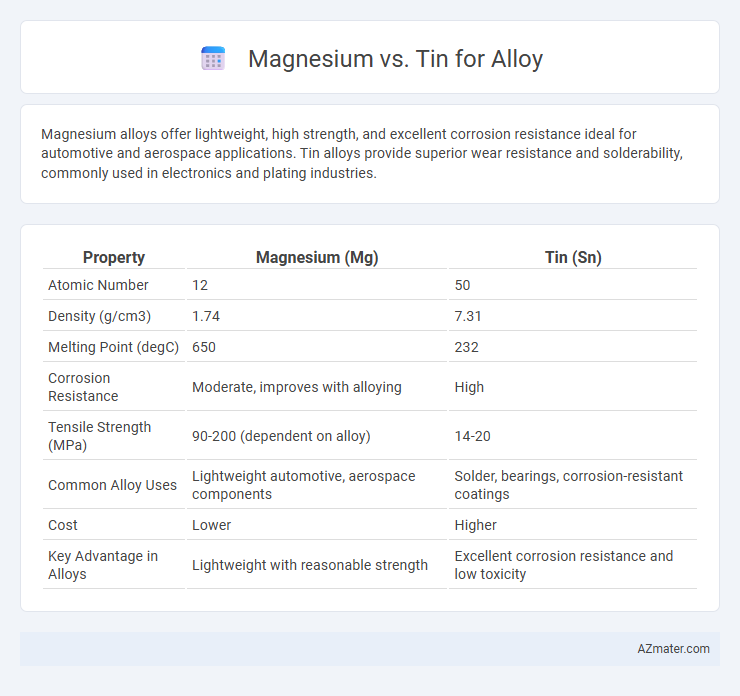Magnesium alloys offer lightweight, high strength, and excellent corrosion resistance ideal for automotive and aerospace applications. Tin alloys provide superior wear resistance and solderability, commonly used in electronics and plating industries.
Table of Comparison
| Property | Magnesium (Mg) | Tin (Sn) |
|---|---|---|
| Atomic Number | 12 | 50 |
| Density (g/cm3) | 1.74 | 7.31 |
| Melting Point (degC) | 650 | 232 |
| Corrosion Resistance | Moderate, improves with alloying | High |
| Tensile Strength (MPa) | 90-200 (dependent on alloy) | 14-20 |
| Common Alloy Uses | Lightweight automotive, aerospace components | Solder, bearings, corrosion-resistant coatings |
| Cost | Lower | Higher |
| Key Advantage in Alloys | Lightweight with reasonable strength | Excellent corrosion resistance and low toxicity |
Introduction to Magnesium and Tin in Alloys
Magnesium and tin are critical elements in alloy development, each offering unique properties that influence alloy performance. Magnesium alloys provide exceptional strength-to-weight ratios and excellent corrosion resistance, making them ideal for automotive and aerospace applications. Tin, often alloyed with copper to form bronze or combined with other metals, improves wear resistance and provides excellent castability and corrosion protection in various industrial applications.
Chemical Properties Comparison
Magnesium alloys exhibit low density, excellent corrosion resistance, and high strength-to-weight ratio due to their hexagonal close-packed crystal structure, making them ideal for lightweight applications. Tin, with its tetragonal crystal system, provides superior corrosion resistance and softness, enhancing alloy malleability but offering lower mechanical strength. The key chemical difference lies in magnesium's strong affinity for oxygen forming a stable oxide layer, whereas tin's oxide is less protective, influencing alloy durability and performance under various environmental conditions.
Mechanical Strength and Durability
Magnesium alloys offer high strength-to-weight ratios and excellent mechanical strength, making them suitable for lightweight applications requiring durability. Tin enhances alloy corrosion resistance and wear resistance but typically reduces overall mechanical strength compared to pure magnesium alloys. Combining magnesium with tin can balance improved durability and moderate strength, with applications favoring corrosion resistance over maximum load-bearing capacity.
Weight and Density Differences
Magnesium alloys have a significantly lower density, approximately 1.74 g/cm3, compared to tin alloys, which typically range around 7.3 g/cm3, making magnesium ideal for lightweight applications such as automotive and aerospace components. The low density of magnesium reduces overall weight without sacrificing strength, while tin alloys, though denser, offer superior corrosion resistance and ductility. Selecting magnesium over tin in alloy design is crucial for industries prioritizing weight reduction and fuel efficiency.
Corrosion Resistance Performance
Magnesium-tin alloys exhibit superior corrosion resistance compared to pure magnesium due to the formation of stable intermetallic phases that act as barriers against oxidative degradation. The addition of tin enhances the alloy's passivation layer, reducing susceptibility to pitting and galvanic corrosion in chloride-rich environments. Consequently, magnesium-tin alloys are preferred in applications demanding improved longevity and reduced maintenance in corrosive conditions.
Cost and Availability Factors
Magnesium alloys generally offer lower cost and higher availability compared to tin-based alloys due to magnesium's abundance and well-established extraction processes. Tin, being less abundant and more expensive, results in higher alloy production costs and limited large-scale availability. The cost-effectiveness and widespread accessibility of magnesium make it a preferred choice for industrial alloy applications where budget and material supply are critical factors.
Alloying Applications in Industry
Magnesium alloys are widely used in automotive and aerospace industries due to their low density, excellent strength-to-weight ratio, and superior corrosion resistance, making them ideal for lightweight structural components. Tin, when alloyed with metals like copper and lead, enhances machinability and corrosion resistance, particularly in soldering, bearing materials, and electronic components. Magnesium-tin alloys combine the lightweight properties of magnesium with the improved creep resistance and thermal stability provided by tin, optimizing performance in high-temperature industrial applications.
Environmental Impact and Sustainability
Magnesium alloys offer significant environmental benefits due to their lightweight nature, contributing to reduced fuel consumption and lower carbon emissions in transportation applications compared to heavier tin-based alloys. Magnesium is also more abundant and easier to recycle, enhancing sustainability through efficient resource utilization and lower ecological footprint during production. Tin, while useful for corrosion resistance, often involves energy-intensive mining and refining processes that increase environmental impact and reduce overall alloy sustainability.
Popular Magnesium- and Tin-Based Alloys
Magnesium-based alloys, such as AZ31 and AZ91, are widely used in aerospace and automotive industries due to their lightweight and excellent strength-to-weight ratio. Tin-based alloys, primarily found in solder materials like tin-lead and tin-silver-copper (SAC) alloys, dominate electronics manufacturing for their superior electrical conductivity and low melting points. The choice between magnesium and tin alloys depends on application requirements; magnesium alloys excel in structural applications, while tin alloys are preferred for electrical connections and corrosion resistance.
Choosing the Right Metal for Your Alloy
Magnesium offers a lightweight, high-strength option for alloys used in automotive and aerospace industries, enhancing fuel efficiency and structural performance. Tin provides excellent corrosion resistance and improved machinability, making it ideal for soldering and coating applications. Selecting between magnesium and tin alloys depends on whether the priority is weight reduction and strength or corrosion resistance and ease of fabrication.

Infographic: Magnesium vs Tin for Alloy
 azmater.com
azmater.com